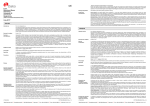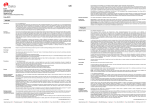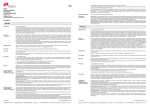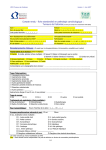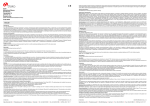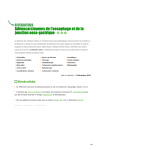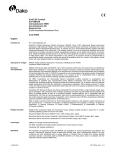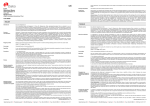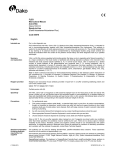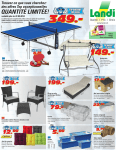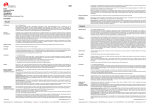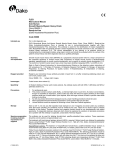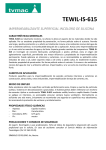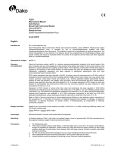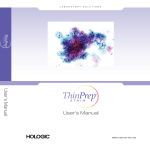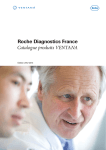Download FLEX Monoclonal Mouse Anti-Human Cytokeratin 19 Clone
Transcript
Performance characteristics FLEX Monoclonal Mouse Anti-Human Cytokeratin 19 Clone RCK108 Ready-to-Use (Dako Autostainer/Autostainer Plus) Abnormal tissues: In malignant human tissues the antibody labeled: 4/4 basal cell and 3/3 well-differentiated keratinizing squamous cell carcinomas of epidermis, 1/1 keratoacanthoma, 1/3 and 1/2 well-differentiated non-keratinizing squamous cell carcinomas of the lip and tongue respectively, 1/5 moderately and 1/1 poorly differentiated tongue squamous cell carcinomas, 1/1 papilloma and 3/3 inverted papillomas of the nasopharynx, 1/3 well, 3/4 moderately and 1/1 poorly differentiated laryngeal squamous cell carcinomas, 7/7 squamous cell carcinomas, 4/4 adenocarcinomas, 1/1 adenosquamous carcinoma and 5/5 small cell lung carcinomas of the respiratory tract, 5/5 pleomorphic adenomas, 3/3 mucoepidermoid carcinomas and 1/1 acinic cell carcinoma of the parotis gland, 6/6 squamous cell carcinomas of esophagus, 4/4 adenocarcinomas, 2/2 carcinoids and 1/1 lymph node metastasis in the stomach, 1/1 adenocarcinoma of the small intestine, 1/1 carcinoid of the appendix, 11/11 adenocarcinomas, 2/2 lymph node metastasis and 1/1 carcinoid of colon, 7/7 adenocarcinomas of pancreas, 6/6 cholangiocellular carcinomas, 12/12 ductal carcinomas, 4/4 lobular carcinomas, 2/2 lymph node metastasis and 4/4 combined ductal/lobular carcinomas of the breast, 2/2 Paget´s disease, 11/11 cystadenocarcinomas, 2/2 clear cell carcinomas and 7/7 endometroidcarcinomas of the ovary, 1/1 malignant Brenner tumor, 4/4 squamous cell carcinomas, 12/12 adenocarcinomas, 8/8 adenosquamous- and 2/2 clear cell carcinomas of cervix, 13/13 endometrioid carcinomas and 3/3 adenosquamous carcinomas of endometrium, 5/5 well and 1/4 moderately differentiated squamous cell carcinomas of vulva, 8/8 adenocarcinomas of prostate, 3/3 malignant teratomas, 2/2 choriocarcinomas, 6/6 renal cell carcinomas, 9/9 urinary bladder carcinomas, 8/8 thyroid gland carcinomas, 1/1 chromophobic and 1/1 acidophil adenoma of the pituitary gland, 4/4 astrocytomas, 4/4 meningiomas and 5/13 leiomyosarcomas (1). In another study, the antibody labeled 5/8 medullary, 26/28 invasive ductal, 4/4 invasive lobular, 5/5 mucinous and 2/2 tubular malignant breast lesions, as well as 12/14 fibroadenomas, 5/5 Phyllodes tumors, 3/3 tubular adenomas, 1/1 Hamartoma, 3/4 intraduct papillomas, 8/8 gynaecomastias and 5/5 fibrocystic changes of the breast (6). Code IS615 ENGLISH For in vitro diagnostic use. Intended use FLEX Monoclonal Mouse Anti-Human Cytokeratin 19, Clone RCK108, Ready-to-Use, (Dako Autostainer/Autostainer Plus), is intended for use in immunohistochemistry together with Dako Autostainer/Autostainer Plus instruments. This antibody labels epithelial cells expressing the cytokeratin 19 protein, and is useful for the identification of epithelial tumors, and may be useful in identifying cholangiocellular carcinomas (1). The clinical interpretation of any staining or its absence should be complemented by morphological studies using proper controls and should be evaluated within the context of the patient's clinical history and other diagnostic tests by a qualified pathologist. Cytokeratin 19 (CK19) belongs to the intermediate filaments, which create a cytoskeleton in almost all cells. In contrast to other intermediate filaments, cytokeratins (CKs) are made up of a highly complex multigene family of polypeptides with molecular masses ranging from 40 to 68 kDa. Twenty distinct CK polypeptides (2, 3) have been revealed in various human epithelial cells (4). They can be divided into an acidic (type I) and a neutral-basic (type II) subfamily. CK19 belongs to the acidic type of cytokeratins, and is a low molecular mass cytokeratin (40 kDa) typically expressed in simple epithelia, superficial, intermediate and basal cells of transitional epithelium as well as luminal, basal and myoepithelial cells in a few complex epithelia. CK19 is normally not expressed in stratified squamous epithelia, but may be present in modified squamous epithelium invaded by lymphocytes as well as in basal cells in non-keratinizing stratified squamous epithelium (2, 4, 5). Summary and explanation Refer to Dako’s General Instructions for Immunohistochemical Staining or the detection system instructions of IHC procedures for: 1) Principle of Procedure, 2) Materials Required, Not Supplied, 3) Storage, 4) Specimen Preparation, 5) Staining Procedure, 6) Quality Control, 7) Troubleshooting, 8) Interpretation of Staining, 9) General Limitations. FRANÇAIS Pour utilisation diagnostique in vitro. Utilisation prévue FLEX Monoclonal Mouse Anti-Human Cytokeratin 19, Clone RCK108, Ready-to-Use, (Dako Autostainer/Autostainer Plus) est destiné à une utilisation en immunohistochimie avec les instruments Dako Autostainer/Autostainer Plus. Cet anticorps marque les cellules épithéliales exprimant la protéine de cytokératine 19, et facilite l’identification des tumeurs épithéliales, et peut s’avérer utile pour l’identification des carcinomes cholangiocellulaires (1). L’interprétation clinique de toute coloration ou son absence doit être complétée par des études morphologiques en utilisant des contrôles appropriés et doit être évaluée en fonction des antécédents cliniques du patient et d’autres tests diagnostiques par un pathologiste qualifié. La cytokératine 19 (CK19) fait partie des filaments intermédiaires, qui créent un cytosquelette dans presque toutes les cellules. À la différence des autres filaments intermédiaires, les cytokératines (CK) sont constituées d’une famille multigénique hautement complexe de polypeptides dont les poids moléculaires varient entre 40 et 68 kDa. Vingt polypeptides de CK distincts (2, 3) ont été identifiés dans diverses cellules épithéliales humaines (4). Les CK peuvent être divisées en sous-familles : type I acide et type II neutre-basique. De type acide, la CK19 est une cytokératine de faible masse moléculaire (40 kDa) exprimée de manière typique dans les épithéliums simples, superficiels et intermédiaires et dans les cellules basales de l’épithélium transitionnel ainsi que dans les cellules luminales, basales et myoépithéliales de quelques rares épithéliums complexes. La CK19 n’est normalement pas exprimée dans les épithéliums squameux stratifiés mais peut être présente dans l’épithélium squameux modifié envahi par les lymphocytes ainsi que dans les cellules basales dans l’épithélium squameux stratifié non kératinisant (2, 4, 5). Résumé et explication Ready-to-use monoclonal mouse antibody provided in liquid form in a buffer containing stabilizing protein and 0.015 mol/L sodium azide. Reagent provided Clone: RCK108. Isotype: IgG1, kappa. Se référer aux Instructions générales de coloration immunohistochimique de Dako ou aux instructions du système de détection relatives aux procédures IHC pour plus d’informations concernant les points suivants : 1) Principe de procédure, 2) Matériels requis mais non fournis, 3) Conservation, 4) Préparation des échantillons, 5) Procédure de coloration, 6) Contrôle qualité, 7) Dépannage, 8) Interprétation de la coloration, 9) Limites générales. Immunogen Cytoskeletal preparation from human bladder cancer cell line T24 (1). Specificity In Western blotting of cytoskeleton preparations from the T24 and RT4 cell lines as well as the human squamous carcinoma cell line HaCaT, the antibody labels a single band corresponding to CK19 (1). Anticorps monoclonal de souris prêt à l’emploi fourni sous forme liquide dans un tampon contenant une protéine stabilisante et 0,015 mol/L d’azide de sodium. Réactifs fournis Clone : RCK108. Isotype : IgG1, kappa. In immunohistochemistry on different human tissues, the antibody labels only epithelia, whereas cells known not to contain CK19, e.g. hepatocytes, are not labeled (1). 1. For professional users. 2. This product contains sodium azide (NaN3), a chemical highly toxic in pure form. At product concentrations, though not classified as hazardous, sodium azide may react with lead and copper plumbing to form highly explosive build-ups of metal azides. Upon disposal, flush with large volumes of water to prevent metal azide build-up in plumbing. 3. As with any product derived from biological sources, proper handling procedures should be used. 4. Wear appropriate Personal Protective Equipment to avoid contact with eyes and skin. 5. Unused solution should be disposed of according to local, State and Federal regulations. Precautions Storage Store at 2-8 °C. Do not use after expiration date sta mped on vial. If reagents are stored under any conditions other than those specified, the conditions must be verified by the user. There are no obvious signs to indicate instability of this product. Therefore, positive and negative controls should be run simultaneously with patient specimens. If unexpected staining is observed which cannot be explained by variations in laboratory procedures and a problem with the antibody is suspected, contact Dako Technical Support. Specimen preparation including materials required but not supplied The antibody can be used for labeling formalin-fixed, paraffin-embedded tissue sections. Tissue specimens should be cut into sections of approximately 4 µm. Pre-treatment with heat-induced epitope retrieval (HIER) is required using Dako PT Link (Code PT100/PT101). For details, please refer to the PT Link User Guide. Optimal results are obtained by pretreating tissues using EnVision FLEX Target Retrieval Solution, High pH (50x) (Code K8010/K8004). Immunogène Préparation cytosquelettique issue de lignée cellulaire T24 de cancer de la vessie humaine (1). Spécificité Dans les analyses par Western blot des préparations cytosquelettiques issues des lignées cellulaires T24 et RT4 ainsi que de la lignée cellulaire HaCaT de carcinome squameux humain, l’anticorps marque une seule bande correspondant à la CK19 (1). Dans l’immunohistochimie de différents tissus humains, l’anticorps marque uniquement les épithéliums, tandis que les cellules connues pour ne pas contenir de CK19, par exemple les hépatocytes, ne sont pas marquées (1). Précautions 1. Pour utilisateurs professionnels. 2. Ce produit contient de l’azide de sodium (NaN3), produit chimique hautement toxique dans sa forme pure. Aux concentrations du produit, bien que non classé comme dangereux, l’azide de sodium peut réagir avec le cuivre et le plomb des canalisations et former des accumulations d’azides métalliques hautement explosifs. Lors de l’élimination, rincer abondamment à l’eau pour éviter toute accumulation d’azide métallique dans les canalisations. 3. Comme avec tout produit d’origine biologique, des procédures de manipulation appropriées doivent être respectées. 4. Porter un vêtement de protection approprié pour éviter le contact avec les yeux et la peau. 5. Les solutions non utilisées doivent être éliminées conformément aux réglementations locales et nationales. Conservation Conserver entre 2 et 8 °C. Ne pas utiliser après la date de péremption indiquée sur le flacon. Si les réactifs sont conservés dans des conditions autres que celles indiquées, celles-ci doivent être validées par l’utilisateur. Il n’y a aucun signe évident indiquant l’instabilité de ce produit. Par conséquent, des contrôles positifs et négatifs doivent être testés en même temps que les échantillons de patient. Si une coloration inattendue est observée, qui ne peut être expliquée par un changement des procédures du laboratoire, et en cas de suspicion d’un problème lié à l’anticorps, contacter l’assistance technique de Dako. Préparation des échantillons y compris le matériel requis mais non fourni L’anticorps peut être utilisé pour le marquage des coupes de tissus inclus en paraffine et fixés au formol. L’épaisseur des coupes d’échantillons de tissu doit être d’environ 4 µm. Paraffin-embedded sections: Pre-treatment of formalin-fixed, paraffin-embedded tissue sections is recommended using the 3-in-1 specimen preparation procedure for Dako PT Link. Follow the pre-treatment procedure outlined in the package insert for EnVision FLEX Target Retrieval Solution, High pH (50x) (Code K8010/K8004). Note: After staining the sections must be dehydrated, cleared and mounted using permanent mounting medium. Deparaffinized sections: Pre-treatment of deparaffinized formalin-fixed, paraffin-embedded tissue sections is recommended using Dako PT Link and following the same procedure as described for paraffin-embedded sections. After staining the slides should be mounted using aqueous or permanent mounting medium. The tissue sections should not dry out during the treatment or during the following immunohistochemical staining procedure. For greater adherence of tissue sections to glass slides, the use of FLEX IHC Microscope Slides (Code K8020) is recommended. Staining procedure including materials required but not supplied The recommended visualization system is EnVision FLEX, High pH, (Dako Autostainer/Autostainer Plus) (Code K8010). The staining steps and incubation times are pre-programmed into the software of Dako Autostainer/Autostainer Plus instruments, using the following protocols: Template protocol: FLEXRTU2 (200 µL dispense volume) or FLEXRTU3 (300 µL dispense volume) Coupes déparaffinées : le prétraitement des coupes tissulaires déparaffinées, fixées au formol et incluses en paraffine, est recommandé à l’aide du Dako PT Link, en suivant la même procédure que pour les coupes incluses en paraffine. Après coloration, un montage aqueux ou permanent des lames est recommandé. The Auxiliary step should be set to “rinse buffer” in staining runs with ≤10 slides. For staining runs with >10 slides the Auxiliary step should be set to “none”. This ascertains comparable wash times. Les coupes de tissus ne doivent pas sécher lors du traitement ni lors de la procédure de coloration immunohistochimique suivante. Pour une meilleure adhérence des coupes de tissus sur les lames de verre, il est recommandé d’utiliser des lames FLEX IHC Microscope Slides (Réf. K8020). All incubation steps should be performed at room temperature. For details, please refer to the Operator’s Manual for the dedicated instrument. If the protocols are not available on the used Dako Autostainer instrument, please contact Dako Technical Services. Optimal conditions may vary depending on specimen and preparation methods, and should be determined by each individual laboratory. If the evaluating pathologist should desire a different staining intensity, a Dako Application Specialist/Technical Service Specialist can be contacted for information on reprogramming of the protocol. Verify that the performance of the adjusted protocol is still valid by evaluating that the staining pattern is identical to the staining pattern described in “Performance characteristics”. Un prétraitement avec démasquage d’épitope induit par la chaleur (HIER) est nécessaire avec le Dako PT Link (Réf. PT100/PT101). Pour plus de détails, se référer au Guide d’utilisation du PT Link. Des résultats optimaux sont obtenus en prétraitant les tissus à l’aide de la EnVision FLEX Target Retrieval Solution, High pH (50x) (Réf. K8010/K8004). Coupes incluses en paraffine : le prétraitement des coupes tissulaires fixées au formol et incluses en paraffine est recommandé à l'aide de la procédure de préparation d'échantillon 3-en-un pour le Dako PT Link. Suivre la procédure de prétraitement indiquée dans la notice de la EnVision FLEX Target Retrieval Solution, High pH (50x) (Réf. K8010/K8004). Remarque : après coloration, les coupes doivent être déshydratées, lavées et montées à l’aide d’un milieu de montage permanent. Autoprogram: CK19 (without counterstaining) or CK19H (with counterstaining) Procédure de coloration y compris le matériel requis mais non fourni Counterstaining in hematoxylin is recommended using EnVision FLEX Hematoxylin, (Dako Autostainer/Autostainer Plus) (Code K8018). Non-aqueous, permanent mounting medium is recommended. Le système de visualisation recommandé est le EnVision FLEX, High pH, (Dako Autostainer/Autostainer Plus) (Réf. K8010). Les étapes de coloration et d’incubation sont préprogrammées dans le logiciel des instruments Dako Autostainer/Autostainer Plus, à l’aide des protocoles suivants : Protocole modèle : FLEXRTU2 (volume de distribution de 200 µL) ou FLEXRTU3 (volume de distribution de 300 µL)Autoprogram : CK19 (sans contre-coloration) ou CK19H (avec contre-coloration) L’étape Auxiliary doit être réglée sur « rinse buffer » lors des cycles de coloration avec ≤10 lames. Pour les cycles de coloration de >10 lames, l’étape Auxiliary doit être réglée sur « none ». Cela garantit des temps de lavage comparables. Positive and negative controls should be run simultaneously using the same protocol as the patient specimens. The positive control tissue should include liver and tonsil and the cells/structures should display reaction patterns as described for these tissues in “Performance characteristics” in all positive specimens. The recommended negative control reagent is FLEX Negative Control, Mouse, (Dako Autostainer/Autostainer Plus) (Code IS750). Staining interpretation Normal tissues: The antibody labels basal layer of epidermis (scattered cell labeling), Merkel cells, sebaceous glands, external root sheath of hair follicles, secretory coil and luminal duct cells of eccrine sweat glands, non-keratinizing squamous epithelium of larynx, mesothelium, columnar ciliated epithelial and basal cells of bronchi, alveolar lining cells, cuboidal and basal cells of the parotis gland, ductal, acinar and basal cells of minor salivary glands, basal cells of esophagus, secretory and neuroendocrine cells of the stomach, villus and crypt epithelium of the small intestine, colon epithelium, ductal and acinar epithelium of pancreas, bile duct epithelium, gall bladder epithelium, columnar cells of lobuli and ducti in breast, columnar- and reserve cells of endocervix, basal cells of ectocervix, endometrial glandular epithelium, placental cytotrophoblast, ductal epithelium, basal cells and seminal vesicles of prostate, rete testis, epithelium of Bowman´s capsule, proximal/distal tubuli and Henle´s loop, transitional epithelium of the bladder, and follicle epithelium of the thyroid gland (1). In liver, the epithelial cells of bile ducts show a moderate to strong cytoplasmic staining reaction, whereas the liver cells are negative. In tonsil, the squamous epithelial cells focally show a weak to moderate cytoplasmic staining reaction that is strongest in the basal layer. Toutes les étapes d’incubation doivent être effectuées à température ambiante. Pour plus de détails, se référer au Manuel de l’opérateur spécifique à l'instrument. Si les protocoles ne sont pas disponibles sur l’instrument Dako Autostainer utilisé, contacter le service technique de Dako. Les conditions optimales peuvent varier en fonction du prélèvement et des méthodes de préparation, et doivent être déterminées par chaque laboratoire individuellement. Si le pathologiste qui réalise l’évaluation désire une intensité de coloration différente, un spécialiste d’application/spécialiste du service technique de Dako peut être contacté pour obtenir des informations sur la re-programmation du protocole. Vérifier que l'exécution du protocole modifié est toujours valide en vérifiant que le schéma de coloration est identique au schéma de coloration décrit dans les « Caractéristiques de performance ». Cells labeled by the antibody display cytoplasmic staining. Il est recommandé d’effectuer une contre-coloration à l’aide de Envision FLEX Hematoxylin, (Dako Autostainer/Autostainer Plus) (Réf. K8018). L’utilisation d’un milieu de montage permanent non aqueux est recommandée. Des contrôles positifs et négatifs doivent être réalisés en même temps et avec le même protocole que les échantillons du patient. Le contrôle de tissu positif doit comprendre le foie et l’amygdale et les cellules/structures doivent présenter des schémas de réaction tels que décrits pour ces tissus dans les (115238-003) Dako Denmark A/S IS615/EFG/MNI/2009.12.04 p. 1/4 | Produktionsvej 42 | DK-2600 Glostrup | Denmark | Tel. +45 44 85 95 00 | Fax +45 44 85 95 95 | CVR No. 33 21 13 17 (115238-003) Dako Denmark A/S IS615/EFG/MNI/2009.12.04 p. 2/4 | Produktionsvej 42 | DK-2600 Glostrup | Denmark | Tel. +45 44 85 95 00 | Fax +45 44 85 95 95 | CVR No. 33 21 13 17 « Caractéristiques de performance » pour tous les échantillons positifs. Le contrôle négatif recommandé est le FLEX Negative Control, Mouse, (Dako Autostainer/Autostainer Plus) (Réf. IS750). Bei Färbedurchläufen mit höchstens 10 Objektträgern sollte der „Zusatz“-Schritt auf „Pufferspülgang“ eingestellt werden. Für Färbedurchläufe mit mehr als 10 Objektträgern den „Zusatz“-Schritt auf „Keine“ einstellen. Dieses gewährleistet vergleichbare Waschzeiten. Interprétation de la coloration Les cellules marquées par l’anticorps présentent une coloration cytoplasmique. Alle Inkubationsschritte sollten bei Raumtemperatur durchgeführt werden. Nähere Einzelheiten bitte dem Benutzerhandbuch für das jeweilige Gerät entnehmen. Wenn die Färbeprotokolle auf dem verwendeten Dako Autostainer-Gerät nicht verfügbar sind, bitte den Technischen Kundendienst von Dako verständigen. Caractéristiques de performance Tissus sains : L’anticorps marque la couche basale de l’épiderme (marquage de cellules disséminées), les cellules de Merkel, les glandes sébacées, la gaine extérieure des follicules pileux, la cellule sécrétoire et les cellules canalaires luminales des glandes sudoripares eccrines, l’épithélium squameux non kératinisant du larynx, le mésothélium, les cellules basales et épithéliales ciliées colonnaires des bronches, les cellules épithéliales alvéolaires, les cellules cubiques et basales de la glande parotide, les cellules canalaires, acinaires et basales des glandes salivaires mineures, les cellules basales de l’œsophage, les cellules sécrétoires et neuroendocrines de l’estomac, les villosités et l’épithélium cryptique de l’intestin grêle, l’épithélium du côlon, l’épithélium canalaire et acinaire du pancréas, l’épithélium des canaux biliaires, l’épithélium de la vésicule biliaire, les cellules colonnaires des lobules et canaux mammaires, les cellules colonnaire et de réserve de l’endocol, les cellules basales de l’exocol, l’épithélium glandulaire endométrial, le cytotrophoblaste placentaire, l’épithélium canalaire, les cellules basales et les vésicules séminales de la prostate, le rete testis, l’épithélium de la capsule de Bowman, les tubules proximaux/distaux et la boucle de Henle, l’épithélium transitionnel de la vessie, ainsi que l’épithélium folliculaire de la glande thyroïdienne (1). Dans le foie, les cellules épithéliales des canaux biliaires présentent une coloration cytoplasmique modérée à forte, tandis que les cellules du foie sont négatives. Dans l’amygdale, les cellules de l’épithélium squameux présentent par endroits une coloration cytoplasmique faible à modérée qui est plus forte dans la couche basale. Tissus tumoraux : Dans les tissus humains malins, l’anticorps a marqué : 4/4 des cellules basales et 3/3 des carcinomes à cellules squameuses kératinisant et bien différenciés de l’épiderme, 1/1 cas de kératoacanthome, 1/3 et 1/2 des carcinomes à cellules squameuses non kératinisants bien différenciés de la lèvre et de la langue respectivement, 1/5 cas de carcinomes à cellules squameuses de la langue modérément différencié et 1/1 cas mal différencié, 1/1 cas de papillome et 3/3 papillomes inversés du nasopharynx, 1/3 carcinomes à cellules squameuses laryngé bien différencié, 3/4 modérément différencié et 1/1 mal différencié, 7/7 carcinomes à cellules squameuses, 4/4 adénocarcinomes, 1/1 carcinome adénosquameux et 5/5 carcinomes pulmonaires à petites cellules des voies respiratoires, 5/5 adénomes pléomorphes, 3/3 carcinomes mucoépidermoïdes et 1/1 cas de carcinome à cellules acinaires de la glande parotide, 6/6 carcinomes à cellules squameuses de l’œsophage, 4/4 adénocarcinomes, 2/2 carcinoïdes et 1/1 cas de métastase des ganglions lymphatiques dans l’estomac, 1/1 cas d’adénocarcinome de l’intestin grêle, 1/1 cas de carcinoïde de l’appendice, 11/11 adénocarcinomes, 2/2 métastases des ganglions lymphatiques et 1/1 cas de carcinoïde du côlon, 7/7 adénocarcinomes du pancréas, 6/6 carcinomes cholangiocellulaires, 12/12 carcinomes canalaires, 4/4 carcinomes lobulaires, 2/2 métastases des ganglions lymphatiques et 4/4 carcinomes canalaires/lobulaires associés du sein, 2/2 cas de maladie de Paget, 11/11 cystadénocarcinomes, 2/2 carcinomes à cellules claires et 7/7 carcinomes endométroïdes de l’ovaire, 1/1 tumeur maligne de Brenner, 4/4 carcinomes à cellules squameuses, 12/12 adénocarcinomes, 8/8 carcinomes du col adénosquameux et 2/2 carcinomes du col à cellules claires, 13/13 carcinomes endométroïdes et 3/3 carcinomes adénosquameux de l’endomètre, 5/5 carcinomes à cellules squameuses de la vulve bien différenciés et 1/4 modérément différencié, 8/8 adénocarcinomes de la prostate, 3/3 tératomes malins, 2/2 choriocarcinomes, 6/6 carcinomes des cellules rénales, 9/9 carcinomes de la vessie, 8/8 carcinomes de la glande thyroïde, 1/1 cas d’adénome chromophobe et 1/1 cas d’adénome acidophile de l’hypophyse, 4/4 astrocytomes, 4/4 méningiomes et 5/13 léiomyosarcomes (1). Au cours d’une autre étude, l’anticorps a marqué 5/8 cas de tumeurs malignes du sein médullaires, 26/28 tumeurs canalaires invasives, 4/4 tumeurs lobulaires invasives, 5/5 tumeurs mucineuses et 2/2 tumeurs tubulaires, ainsi que 12/14 fibroadénomes, 5/5 tumeurs phyllodes, 3/3 adénomes tubulaires, 1/1 cas d’hamartome, 3/4 papillomes intracanalaires, 8/8 gynécomasties et 5/5 évolutions fibrokystiques du sein (6). Optimale Bedingungen können je nach Probe und Präparationsverfahren unterschiedlich sein und sollten vom jeweiligen Labor selbst ermittelt werden. Falls der beurteilende Pathologe eine andere Färbungsintensität wünscht, kann ein Anwendungsspezialist oder Kundendiensttechniker von Dako bei der Neuprogrammierung des Protokolls helfen. Die Leistung des angepassten Protokolls muss verifiziert werden, indem gewährleistet wird, dass das Färbemuster mit dem unter „Leistungsmerkmale“ beschriebenen Färbemuster identisch ist. Die Gegenfärbung in Hämatoxylin sollte mit EnVision™ FLEX Hematoxylin, (Dako Autostainer/Autostainer Plus) (Code-Nr. K8018) ausgeführt werden. Empfohlen wird ein nichtwässriges, permanentes Fixiermittel. Positiv- und Negativkontrollen sollten zur gleichen Zeit und mit demselben Protokoll wie die Patientenproben getestet werden. Das positive Kontrollgewebe sollte Leber- und Mandelgewebe enthalten und die Zellen/Strukturen müssen in allen positiven Proben die für dieses Gewebe unter „Leistungsmerkmale“ beschriebenen Reaktionsmuster aufweisen. Das empfohlene Negativ-Kontrollreagenz ist FLEX Negative Control, Mouse, (Dako Autostainer/Autostainer Plus) (Code-Nr. IS750). Auswertung der Färbung Mit diesem Antikörper markierte Zellen weisen ein zytoplasmatisches Färbemuster auf. Leistungsmerkmale Gesundes Gewebe: Der Antikörper markiert Basalzellen der Epidermis (verstreute Zellmarkierung), Merkel-Zellen, Talgdrüsen, äußere Zellen der Haarwurzelscheiden, sekretorische Zellen der ekkrinen Schweißdrüsengänge und Lumenauskleidungszellen, nicht keratinisierendes Plattenepithel des Larynx, Mesothel, mit Zilien versehenes Zylinderepithel und Basalzellen der Bronchi, Alveolarauskleidungszellen, kuboide und basale Zellen der Parotis, duktale, azinäre und basale Zellen der kleinen Speicheldrüsen, Basalzellen der Speiseröhre, sekretorische und neuroendokrine Zellen des Magens, Epithel der Villi und der Krypten im Dünndarm, Dickdarmepithel, Epithel der Acini und Gänge des Pankreas, Epithelzellen der Gallenwege und der Gallenblase, Zylinderepithelzellen der Brustdrüsenläppchen und -gänge, Zylinder- und Reservezellen des Endozervix, Basalzellen des Ektozervix, Drüsenepithel im Endometrium, Zytotrophoblasten der Plazenta, Drüsengangepithel, Basalzellen und Samenbläschen der Prostata, Rete testis, Epithelzellen der Bowman-Kapsel, proximale und distale Tubuli sowie die Henlesche Schleife, Übergangsepithel der Harnblase und Follikelepithel der Schilddrüse (1). In der Leber weisen die Epithelzellen der Gallengänge eine mäßige bis starke zytoplasmatische Färbereaktion auf, während die Leberzellen negativ sind. In Mandelgewebe zeigen die Plattenepithelzellen fokal eine schwache bis mäßige zytoplasmatische Färbereaktion, die in der Basalschicht stärker ist. Pathologisches Gewebe: In malignen humanen Geweben markierte der Antikörper: 4 von 4 Basalzellen und 3 von 3 gut differenzierten keratinisierenden Plattenepithelkarzinomen der Epidermis, 1 von 1 Keratoakanthom, 1 von 3 und 1 von 2 gut differenzierten, nicht keratinisierenden Plattenepithelkarzinomen der Lippe bzw. der Zunge, 1 von 5 mäßig und 1 von 1 wenig differenzierten Plattenepithelkarzinomen der Zunge, 1 von 1 Papillom und 3 von 3 Inversionspapillomen des Nasopharynx, 1 von 3 gut, 3 von 4 mäßig und 1 von 1 wenig differenzierten Plattenepithelkarzinomen des Larynx, 7 von 7 Platteneptihelkarzinomen, 4 von 4 Adenokarzinomen, 1 von 1 adenosquamösen Karzinom und 5 von 5 Kleinzellen-Lungenkarzinomen des Respirationstrakts, 5 von 5 pleomorphen Adenomen, 3 von 3 Mucoepidermoidkarzinomen und 1 von 1 Azinärzellenkarzinom der Parotisdrüse, 6 von 6 Plattenepithelkarzinomen der Speiseröhre, 4 von 4 Adenokarzinomen, 2 von 2 Karzinoiden und 1 von 1 Lymphknotenmetastase im Magen, 1 von 1 Adenokarzinom des Dünndarms, 1 von 1 Karzinoid des Appendix, 11 von 11 Adenokarzinomen, 2 von 2 Lymphknotenmetastasen und 1 von 1 Karzinoid des Dickdarms, 7 von 7 Adenokarzinomen der Bauchspeicheldrüse, 6 von 6 cholangiozellulären Karzinomen, 12 von 12 duktalen Karzinomen, 4 von 4 lobulären Karzinomen, 2 von 2 Lymphknotenmetastasen und 4 von 4 gemischt duktalen/lobulären Karzinomen der Brust, 2 von 2 Fällen von Paget-Krankheit, 11 von 11 Zystadenokarzinomen, 2 von 2 Klarzellkarzinomen und 7 von 7 EierstockEndometroidkarzinomen, 1 von 1 malignen Brenner-Tumor, 4 von 4 Plattenepithelkarzinomen, 12 von 12 Adenokarzinomen, 8 von 8 adenosquamösen und 2 von 2 Klarzellkarzinomen des Zervix, 13 von 13 Endometrioidkarzinomen und 3 von 3 adenosquamösen Karzinomen des Endometriums, 5 von 5 gut und 1 von 4 mäßig differenzierten Plattenepithelkarzinomen der Vulva, 8 von 8 Prostata-Adenokarzinomen, 3 von 3 malignen Teratomen, 2 von 2 Choriokarzinomen, 6 von 6 Nierenzellkarzinomen, 9 von 9 Harnblasenkarzinomen, 8 von 8 Schilddrüsenkarzinomen, 1 von 1 chromophoben und 1 von 1 azidophilen Hypophysendenom, 4 von 4 Astrozytomen, 4 von 4 Meningiomen und 5 von 13 Leiomyosarkomen (1). In einer anderen Studie markierte der Antikörper 5 von 8 medullären, 26 von 28 invasiven duktalen, 4 von 4 invasiven lobulären, 5 von 5 muzinösen und 2 von 2 tubulären malignen Brustläsionen sowie 12 von 14 Fibroadenomen, 5 von 5 Phyllodestumoren, 3 von 3 tubulären Adenomen, 1 von 1 Hamartom, 3 von 4 intraduktären Papillomen, 8 von 8 Gynäkomastien und 5 von 5 fibrozystischen Veränderungen der Brust (6). DEUTSCH Zur In-vitro-Diagnostik. Verwendungszweck FLEX Monoclonal Mouse Anti-Human Cytokeratin 19, Clone RCK108, Ready-to-Use, (Dako Autostainer/Autostainer Plus) ist zur Verwendung in der Immunhistochemie in Verbindung mit Dako Autostainer/Autostainer Plus-Geräten bestimmt. Dieser Antikörper markiert Epithelzellen, auf denen Zytokeratin-19Protein exprimiert wird und dient zum Nachweis von Epitheltumoren und kann bei der Identifizierung cholangiozellulärer Karzinomere hilfreich sein (1). Die klinische Auswertung einer eventuell eintretenden Färbung sollte durch morphologische Studien mit ordnungsgemäßen Kontrollen ergänzt werden und von einem qualifizierten Pathologen unter Berücksichtigung der Krankengeschichte und anderer Diagnostiktests des Patienten vorgenommen werden. Cytokeratin 19 (CK19) gehört zu den Intermediärfilamenten, die in fast allen Zellen ein Zytoskelett bilden. Im Gegensatz zu anderen Intermediärfilamenten bestehen Zytokeratine (ZK) aus einer hochkomplexen multigenen Familie von Polypeptiden, deren Molekulargewicht von 40 bis 68 kDa reicht. Bisher wurden 20 unterschiedliche ZK-Polypeptide (2, 3) in verschiedenen humanen Epithelzellen entdeckt (4). Die ZK lassen sich in einen sauren Typ A (Klasse I) und einen neutral-basischen Typ B (Klasse II) unterteilen. CK19 gehört dem sauren Typ der Zytokeratine an. Es handelt sich um ein Zytokeratin von niedrigem Molekulargewicht (40 kDa), das typischerweise in einfachen Epithelzellen, oberflächlichen, intermediären und basalen Zellen des Übergangsepithels sowie in luminalen, basalen und myoepithelialen Zellen einiger komplexer Epithelgewebe vorkommt. Zusammenfassung und Erklärung References/ Références/ Literatur 1. Kwaspen FHL, Smedts FMM, Broos A, Bulten H, Debie WMH et al. Reproducible and highly sensitive detection of the broad spectrum epithelial marker keratin 19 in routine cancer diagnosis. Histopathol 1997; 31:503-16. CK19 wird normalerweise nicht in mehrschichtigem Plattenepithel exprimiert, kann aber in modifiziertem Plattenepithel vorkommen, das von Lymphozyten durchdrungen ist, sowie in Basalzellen des nicht keratinisierenden mehrschichtigen Plattenepithelgewebes (2, 4, 5). 2. Moll R, Franke WW, Schiller DL, Geiger B, Krepler R. The catalog of human cytokeratins: patterns of expression in normal epithelia, tumors and cultured cells. Cell 1982; 31:11-24. 3. Moll R, Löwe A, Laufer J, Franke WW. Cytokeratin 20 in human carcinomas. A new histodiagnostic marker detected by monoclonal antibodies. Am J Pathol 1992; 140:427-47. Folgende Angaben bitte den Allgemeinen Richtlinien zur immunhistochemischen Färbung von Dako oder den Anweisungen des Detektionssystems für IHCVerfahren entnehmen: 1) Verfahrensprinzip, 2) Erforderliche, aber nicht mitgelieferte Materialien, 3) Aufbewahrung, 4) Vorbereitung der Probe, 5) Färbeverfahren, 6) Qualitätskontrolle, 7) Fehlersuche und -behebung, 8) Auswertung der Färbung, 9) Allgemeine Beschränkungen. 4. Moll R. Cytokeratins as markers of differentiation in the diagnosis of epithelial tumors. Subcell Biochem 1998; 31: 205-62. 5. Lane EB, Alexander CM. Use of keratin antibodies in tumor diagnosis. In: Osborn M, ed. Seminars in Cancer Biology. Antibodies in Diagnosis and Therapy. Philadelphia: Saunders, 1990:165-79. 6. Dalal P, Shousha S. keratin 19 in paraffin sections of medullary carcinoma and other benign and malignant breast lesions. Mod Pathol 1995; 8:413-6. Gebrauchsfertiger, monoklonaler Maus-Antikörper in flüssiger Form in einem Puffer, der stabilisierendes Protein und 0,015 mol/L Natriumazid enthält. Geliefertes Reagenz Klon: RCK108. Isotyp: IgG1, Kappa. Immunogen Zellgerüstpräparation aus menschlicher Harnblasenkarzinom-Zelllinie T24 (1). Spezifität Beim Western-Blotting der Zellgerüstpräparate aus den Zelllinien T24 und RT4 sowie aus der HaCaT-Zelllinie von menschlichem Plattenepithelkarzinom markiert der Antikörper eine CK19 entsprechende Bande (1). Immunhistochemisch markiert der Antikörper an unterschiedlichen menschlichen Geweben ausschließlich Epithelzellen, während andere Zellen, die bekanntlich kein CK19 enthalten, z. B. Hepatozyten, nicht markiert werden (1). Vorsichtsmaßnahmen 1. Nur für Fachpersonal bestimmt. 2. Dieses Produkt enthält Natriumazid (NaN3), eine in reiner Form äußerst giftige Chemikalie. Natriumazid kann auch in als ungefährlich eingestuften Konzentrationen mit Blei- und Kupferrohren reagieren und hochexplosive Metallazide bilden. Nach der Entsorgung stets mit viel Wasser nachspülen, um Metallazidansammlungen in den Leitungen vorzubeugen. 3. Wie alle Produkte biologischen Ursprungs müssen auch diese entsprechend gehandhabt werden. 4. Geeignete Schutzkleidung tragen, um Augen- und Hautkontakt zu vermeiden. 5. Nicht verwendete Lösung ist entsprechend örtlichen, bundesstaatlichen und staatlichen Richtlinien zu entsorgen. Explanation of symbols/ Explication des symboles/ Erläuterung der Symbole Lagerung Bei 2–8 °C aufbewahren. Nach Ablauf des auf dem Fläschch en aufgedruckten Verfalldatums nicht mehr verwenden. Werden die Reagenzien unter anderen als den angegebenen Bedingungen aufbewahrt, müssen diese Bedingungen vom Benutzer validiert werden. Es gibt keine offensichtlichen Anzeichen für eine eventuelle Produktinstabilität. Positiv- und Negativkontrollen sollten daher zur gleichen Zeit wie die Patientenproben getestet werden. Falls es zu einer unerwarteten Färbung kommt, die sich nicht durch Unterschiede bei Laborverfahren erklären lässt und auf ein Problem mit dem Antikörper hindeutet, ist der technische Kundendienst von Dako zu verständigen. Vorbereitung der Probe und erforderliche, aber nicht mitgelieferte Materialien Der Antikörper eignet sich zur Markierung von formalinfixierten und paraffineingebetteten Gewebeschnitten. Gewebeproben sollten in Schnitte von ca. 4 µm Stärke geschnitten werden. Catalogue number Référence catalogue Bestellnummer Temperature limitation Limites de température Use by Utiliser avant Zulässiger Temperaturbereich Verwendbar bis In vitro diagnostic medical device Dispositif médical de diagnostic in vitro In-vitro-Diagnostikum Contains sufficient for <n> tests Contenu suffisant pour <n> tests Manufacturer Fabricant Inhalt ausreichend für <n> Tests Hersteller Consult instructions for use Voir les instructions d’utilisation Gebrauchsanweisung beachten Batch code Numéro de lot Chargenbezeichnung Die Vorbehandlung durch hitzeinduzierte Epitopdemaskierung (HIER) mit Dako PT Link (Code-Nr. PT100/PT101) ist erforderlich. Weitere Informationen hierzu siehe PT Link-Benutzerhandbuch. Optimale Ergebnisse können durch Vorbehandlung der Gewebe mit EnVision FLEX Target Retrieval Solution, High pH (50x) (Code-Nr. K8010/K8004) erzielt werden. Paraffineingebettete Schnitte: Die Vorbehandlung der formalinfixierten, paraffineingebetteten Schnitte mit dem 3-in-1-Probenvorbereitungsverfahren für Dako PT Link wird empfohlen. Vorbehandlung gemäß der Beschreibung in der Packungsbeilage für EnVision FLEX Target Retrieval Solution, High pH (50x) (Code-Nr. K8010/K8004) durchführen. Hinweis: Nach dem Färben müssen die Schnitte dehydriert, geklärt und mit permanentem Einbettmedium auf den Objektträger aufgebracht werden. Entparaffinierte Schnitte: Eine Vorbehandlung der entparaffinierten, formalinfixierten, paraffineingebetteten Gewebeschnitte mit Dako PT Link nach demselben Verfahren, wie für die paraffineingebetteten Schnitte beschrieben, wird empfohlen. Die Objektträger nach dem Färben mit einem wässrigen oder permanenten Einbettmedium bedecken. Die Gewebeschnitte dürfen während der Behandlung oder des anschließenden immunhistochemischen Färbeverfahrens nicht austrocknen. Zur besseren Haftung der Gewebeschnitte an den Glasobjektträgern wird die Verwendung von FLEX IHC Microscope Slides (Code-Nr. K8020) empfohlen. Färbeverfahren und erforderliche, aber nicht mitgelieferte Materialien (115238-003) Dako Denmark A/S Das empfohlene Visualisierungssystem ist EnVision™ FLEX, High pH (Dako Autostainer/Autostainer Plus)(Code-Nr. K8010). Die Färbeschritte und Inkubationszeiten sind in der Software der Dako Autostainer/Autostainer Plus-Geräte mit den folgenden Protokollen vorprogrammiert: Matrix-Protokoll: FLEXRTU2 (200 µL Abgabevolumen) oder FLEXRTU3 (300 µL Abgabevolumen) Autoprogram: CK19 (ohne Gegenfärbung) oder CK19H (mit Gegenfärbung) IS615/EFG/MNI/2009.12.04 p. 3/4 | Produktionsvej 42 | DK-2600 Glostrup | Denmark | Tel. +45 44 85 95 00 | Fax +45 44 85 95 95 | CVR No. 33 21 13 17 (115238-003) Dako Denmark A/S IS615/EFG/MNI/2009.12.04 p. 4/4 | Produktionsvej 42 | DK-2600 Glostrup | Denmark | Tel. +45 44 85 95 00 | Fax +45 44 85 95 95 | CVR No. 33 21 13 17


